Discovering the Mall of the Emirates Metro Station
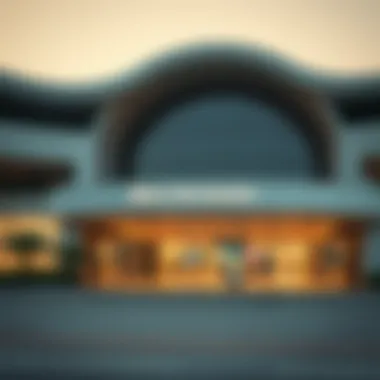
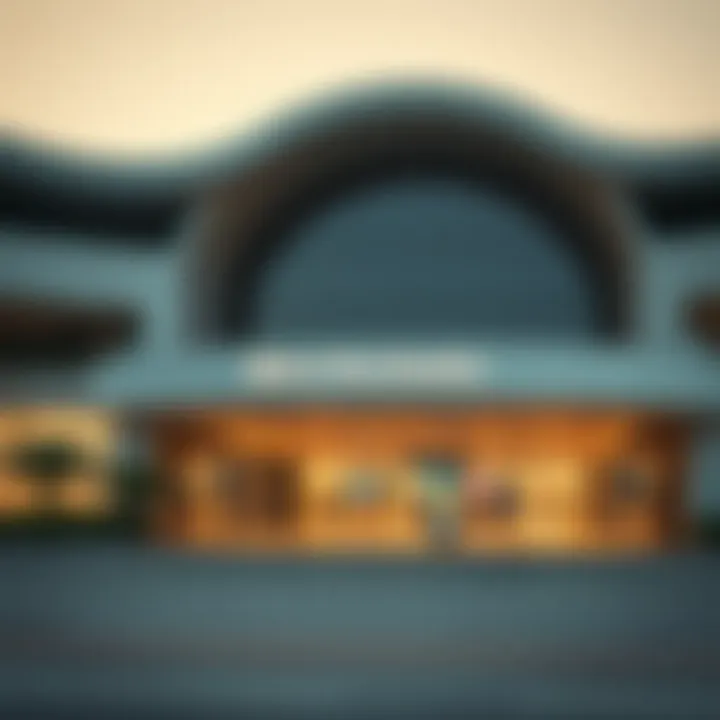
Intro
In the bustling heart of Dubai lies the Mall of the Emirates metro station, a crucial juncture that links the modern luxuries of the mall to the intricate web of the city’s transport system. With the metro station nestled among high-end boutiques and lavish amenities, it stands as more than just a transit point; it embodies the growth and dynamism of Dubai’s urban landscape. The significance of this station cannot be overstated, as it has transformed not only the commute of daily travelers but also the real estate landscape surrounding it.
As we embark on this exploration, it’s pivotal to delve into the interplay between the station's architectural elegance and the evolving patterns of Dubai's real estate market. The station serves a dual purpose—facilitating mobility and fueling property investment opportunities in its vicinity. In the subsequent sections, we will unravel the current trends shaping the real estate scene in Dubai, highlight potential investment strategies for prospective buyers, and analyze the long-term impacts of this sophisticated transit hub.
Overview of the Mall of the Emirates Metro Station
The Mall of the Emirates Metro Station stands as a cornerstone in Dubai's expanding transport framework. This station does not merely serve as a point for commuters but acts as a vital link that connects the pulses of urban life with the essence of the city’s attractions. Situated strategically close to one of the most iconic malls in the region, the station embodies convenience and efficiency that appeals not only to locals but also to tourists exploring Dubai’s diverse offerings.
The significance of the Mall of the Emirates Metro Station can’t be overstated. Central to its design is the aim of enhancing accessibility, thereby benefiting both residents and visitors. The nearby mall, renowned for its vast array of shopping and leisure options, becomes more attractive as it becomes seamlessly integrated into the public transport system. This linkage emphasizes the importance of sustainable infrastructure in urban development—a concept that is especially relevant in rapidly expanding cities like Dubai.
Historical Context
The establishment of the Mall of the Emirates Metro Station is rooted in Dubai's ambition to revolutionize public transportation. The inception of the Dubai Metro system itself dates back to the early 2000s, driven by the need to alleviate traffic congestion and provide an alternative to the private vehicle-centric culture prevalent at that time. As part of this vision, the Mall of the Emirates station was inaugurated in 2010, coinciding with the increase in both local population and tourist numbers, which also marked the mall’s growth.
In these past years, the station has become more than just a transport node; it reflects the socio-economic changes throughout the city. It plays a key role in promoting public transit usage, which aligns with Dubai’s broader environmental goals, pushing for a greener, more sustainable approach to city navigation.
Location and Accessibility
Positioned conveniently on Sheikh Zayed Road, the Mall of the Emirates Metro Station boasts exceptional accessibility. Its prime location makes it a nexus for several transport modes. Notably, the station is equipped for seamless transfers to buses and taxis, offering commuters flexibility in their travel choices. Further enhancing its appeal is the proximity of the station to various business districts and residential areas, reducing commute times significantly.
Accessibility is further bolstered by pedestrian-friendly pathways leading directly to the mall, ensuring that both locals and visitors can easily navigate their way to various attractions in the area. Whether one is heading to the indoor ski slopes of Ski Dubai or indulging in a shopping spree, the station provides an efficient gateway, removing the hassle of parking and traffic.
By addressing these elements, the Mall of the Emirates Metro Station not only enhances the transportation landscape of Dubai but also symbolizes the city's commitment to implementing a progressive, cohesive transport strategy.
Architectural Design and Features
The architectural design of the Mall of the Emirates metro station stands as a testament to modern engineering and aesthetic sensibility within Dubai's urban landscape. It is not just a transit point; it is a representation of the intersection between form and function. Designing metro stations that can comfortably handle the influx of daily commuters while enriching the area’s visual appeal is a balancing act that has been executed artfully in this case.
Modern Aesthetics
The modern aesthetics of the Mall of the Emirates metro station go beyond mere visual impact. The exteriors showcase sleek lines and a contemporary façade, crafted to resonate with Dubai's image as a city of progress and luxury. This design reflects the aspirations of a metropolitan area that prides itself on innovation. The green accents woven into the structure evoke a sense of tranquility amid the bustling environment.
To deliver a visually striking and functional environment, the station utilizes expansive glass panels that allow natural light to flood in. The interiors are more than just place where people come to wait; they feel spacious and inviting. Such features not only enhance user experience but also signal a departure from traditional, monolithic transit structures. People are often seen gathering under the skylights, turning an ordinary station into a social space, which is ideal for travelers and commuters alike.
Sustainability Considerations
In today’s world, sustainability in architectural design is not a luxury; it's a necessity. The Mall of the Emirates metro station incorporates several eco-friendly design principles that reflect a commitment to minimizing ecological footprints. These designs include energy-efficient lighting and advanced insulation techniques, which significantly reduce energy consumption. The choice of materials resonates with environmentally-friendly standards, and local sourcing is often prioritized to lower carbon emissions associated with transportation.
Implementing rainwater harvesting systems and green roofs are additional sustainable features that help manage stormwater runoff and provide natural insulation. These systems are vital for a city like Dubai, where seasonal rains can lead to significant water wastage. This approach also aligns with global trends towards sustainable urbanism, showcasing Dubai's commitment to being a modern city that owns its environmental responsibilities.
Integration with Dubai's Metro System
The Mall of the Emirates Metro Station stands as a crucial cog in the vast machinery of Dubai's metro network. This integration not only enhances commuter convenience but also contributes significantly to the socio-economic landscape of the region. As we navigate the intricate benefits and considerations surrounding this integration, it becomes clear that the metro station serves as more than just a transit point—it is a gateway fostering connectivity across the vibrant heart of Dubai.
Key Connections
One of the standout features of the Mall of the Emirates Metro Station is its strategic positioning along the Red Line of the Dubai Metro. This key connection allows passengers to seamlessly access a multitude of important destinations throughout the city. Here are some notable points:
- Proximity to Landmarks: Being adjacent to the renowned Mall of the Emirates, the station offers direct access to a hub of shopping, entertainment, and leisure activities. Visitors can easily transition from shopping sprees to catching a ride home.
- Direct Links: The metro line connects commuters not only to the bustling malls but also to important residential and business districts, including Dubai Marina and Bur Dubai. This fosters ease of travel that can be a game changer for daily commuters and tourists alike.
- Intermodal Access: Integration with different modes of transportation, such as buses and taxis, ensures that travelers find themselves just a hop, skip, and jump away from their final destinations. This creates an efficient transit experience, significantly cutting travel time.
Transfer Options
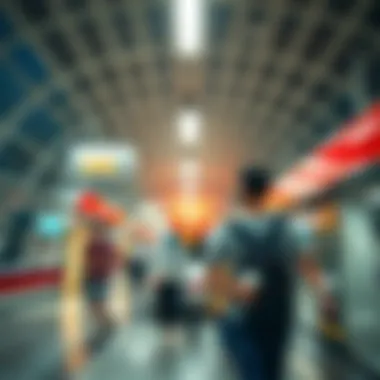

At the Mall of the Emirates Metro Station, transfer options are not just an afterthought; they are thoughtfully designed to ensure smooth transitions between services. Here’s what you can expect:
- Bus Connectivity: A dedicated bus terminal is situated adjacent to the metro station, offering numerous routes that connect to various points in the city. This is particularly beneficial for those working in areas not directly serviced by the metro.
- Taxi Stands: For those who prefer a more direct route, a series of well-organized taxi stands right outside the station provide a hassle-free way to jump into a cab and continue the journey without delay.
- Future Developments: Plans for further improving transfer facilities are in the pipeline. Potential enhancements could include more bike-sharing options and electric vehicle charging stations, promoting eco-friendly practices and improving overall commuter experience.
"Well-connected metro stations are more than transport hubs; they are keys to unlocking the potential of urban living."
The integration of the Mall of the Emirates Metro Station into Dubai's metro system exemplifies a deliberate effort to enhance urban connectivity while supporting the region's dynamic growth. As the city evolves, this station will undoubtedly play a significant role in shaping its transportation landscape, thereby influencing real estate trends and commuter behavior for years to come.
Impact on Real Estate Development
The Mall of the Emirates metro station is a critical pivot in Dubai's urban fabric, affecting real estate development in significant ways. Its location, connectivity, and design have spurred growth in the surrounding areas, making it an attractive spot for investors and homebuyers alike. Understanding its influence on property trends and investment opportunities is vital for those navigating the Dubai real estate market.
Surrounding Property Trends
With the metro station acting as a catalyst, property trends in the vicinity have witnessed remarkable shifts. Enhanced accessibility has made neighborhoods adjacent to the Mall of the Emirates more desirable. Residential and commercial properties have seen a marked increase in value due to the station's convenience. Buyers are showing greater interest in properties that minimize commuting times, leading to a premium on real estate situated near the station.
The types of properties that have gained traction include:
- Residential complexes: Many developers are rushing to offer luxury apartments and townhouses that target expatriates and young professionals seeking a cosmopolitan lifestyle.
- Retail spaces: With foot traffic increasing due to the metro’s proximity, retail outlets are more willing to invest in areas nearby. Businesses find themselves in a better position to tap into a steady stream of customers.
- Mixed-use developments: Projects that integrate living, working, and leisure spaces are on the rise. This approach caters to the modern urbanite who prefers staying close to work and entertainment options.
As these trends unfold, investors are keenly observing the evolution as property values continue to rise, indicating a robust long-term investment outlook.
Investment Opportunities
Investing around the Mall of the Emirates metro station presents a myriad of opportunities. Given the growth observed thus far, prospective investors can explore different avenues:
- Residential units for renting: Due to its appeal to expatriates and tourists, buying properties to lease to long-term renters can yield consistent returns.
- Commercial real estate: Retail environments and offices situated close to the metro station stand to gain from the rising demand created by increased foot traffic.
- Community-centric projects: Developers are being encouraged to create multifaceted living environments that merge residential space with commercial amenities. This interest highlights a shift towards sustainable living that communities appreciate.
In summary, the Mall of the Emirates metro station is more than just a transportation hub; it functions as a springboard for real estate growth. As property values rise and new investment opportunities arise, stakeholders in Dubai's real estate market must remain vigilant and proactive, ensuring they capitalize on the ongoing trend’s momentum. When poorly taken advantage of, the influx can cause challenges; hence strategic planning should always be at the forefront of real estate ventures.
The proximity of the Mall of the Emirates metro station to surrounding developments has redefined property investment strategies, emphasizing the essential nature of connectivity in real estate growth.
Ultimately, the intersection of transit and property development around the Mall of the Emirates metro station shapes Dubai's real estate landscape into a dynamic and shifting terrain, ripe for exploration.
Commuter Experience
Understanding the commuter experience at the Mall of the Emirates Metro Station is not just essential for those who use this facility daily but also offers insights into how public transport shapes urban living in Dubai. A seamless commute can impact people's lives greatly, making it central to their daily routines.
Facilities and Amenities
The Mall of the Emirates Metro Station is equipped with a variety of facilities that cater to the diverse needs of its users. From year-round shoppers to daily commuters, convenience is at the forefront. Here are some notable amenities that enrich the commuter experience:
- Glorious Waiting Areas: Spacious, well-ventilated platforms designed for comfort allow passengers to wait without feeling cramped. Just imagine stepping off a long day at work and having a peaceful place to relax while you wait for your train.
- Retail Options: Making tracks for a bullet train is far less tedious when you can grab a cup of coffee or small snack. The station features kiosks and small shops, allowing for a quick pit stop.
- Accessibility: Elevators and escalators help individuals with reduced mobility navigate through the station easily. It’s more than just buildings and transport; it’s about inclusivity too, ensuring everyone can access the metro effortlessly.
- Free Wi-Fi: Noting down your latest thoughts or scrolling through social media before the shift becomes light when free Wi-Fi is available. Staying connected on the go is vital for many commuters.
By incorporating these facilities, the Mall of the Emirates Metro Station not only enhances the efficiency but also ensures comfort and convenience for all who pass through.
Safety and Security Measures
The safety and security measures in place contribute significantly to the overall experience for commuters. A secure environment creates a sense of trust and encourages people to use the metro. Here are key elements that bolster safety at the station:
- CCTV Surveillance: Cameras positioned throughout the facility help ensure a vigilant eye is always on the lookout for anything unusual. Commuters can feel at ease knowing their safety is being prioritized.
- Trained Security Personnel: The presence of well-trained staff adds another layer of assurance. These individuals can intervene swiftly in case of emergencies, engaging with commuters and providing a reassuring smile.
- Emergency Protocols: Clearly displayed emergency plans guide commuters in case of unforeseen events. Knowledge is power, and being informed often reduces panic during critical moments.
"A safe metro experience isn’t just about feeling secure but also about the assurance that help is readily available when needed."
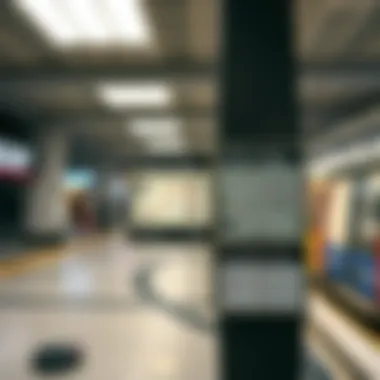
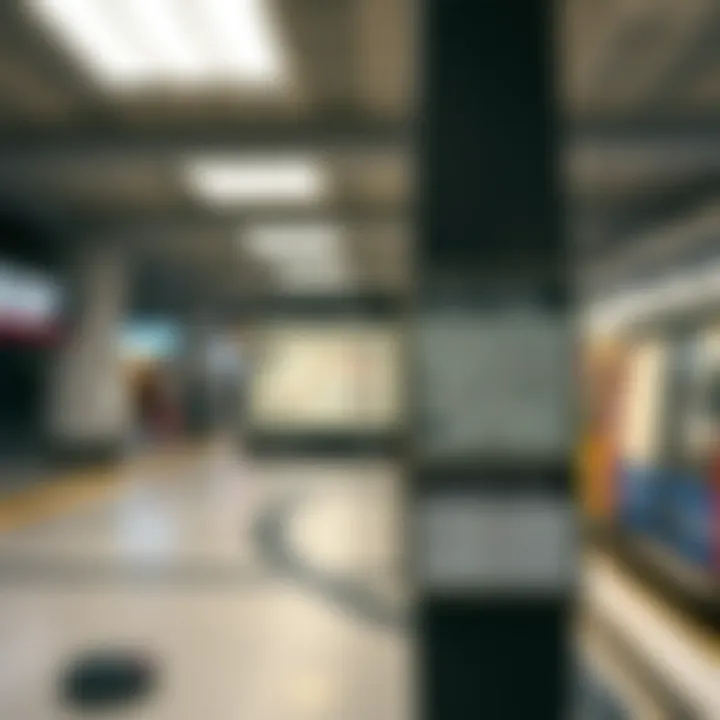
- Health Safety Regulations: Following recent global events, the implementation of health protocols ensures that commuters travel in a healthy environment. Frequent sanitation and mask mandates have become part of the norm, allowing passengers to feel protected.
In summary, the Mall of the Emirates Metro Station succeeds in enhancing the commuter experience largely through its excellent facilities and comprehensive safety measures. This convergence of comfort and security enables efficiency in transport, ultimately contributing to the dynamic fabric of Dubai's urban life.
Connecting Communities
The Mall of the Emirates metro station is much more than just a stop on Dubai's metro line; it serves as a vital link that connects various communities within the bustling city. By providing easy access to different neighborhoods, the station enhances mobility for residents, workers, and visitors alike. The impact of this connectivity extends far beyond mere convenience; it fosters a sense of community and encourages social interactions.
Social Impact
When you step off the train at the Mall of the Emirates, the first thing that strikes you is the diverse crowd. People from various walks of life converge here, hinting at a microcosm of Dubai itself. This intermingling of cultures and backgrounds not only enriches the social fabric of the area but also promotes understanding and tolerance among its inhabitants.
The presence of the station has transformed the neighboring streets. Families can now easily visit the famed shopping mall, tourists can explore nearby attractions, and employees commuting to their jobs benefit from reduced travel times. This efficient transport link can dramatically enhance lifestyles, particularly for lower-income groups who may have limited transportation options. According to one study, having access to public transport can increase job prospects by 25%.
Moreover, events and community gatherings are often held in this vicinity, encouraging participation from a broader demographic. Whether it's a cultural festival or a local market, the metro station acts as the gateway to these community events, making them accessible to all. Thus, it’s not just a point of transit; it’s a space where community bonds can blossom.
Cultural Significance
The cultural significance of the Mall of the Emirates metro station unfolds on multiple layers, reflecting the rich heritage and modern dynamism of Dubai. This station serves as a cultural showcase in more ways than one. It’s positioned right near the Mall of the Emirates, a landmark attraction that offers everything from world-class shopping to the Ski Dubai indoor ski resort.
The station's design cleverly incorporates elements that celebrate the local culture while also embracing global influences. Artwork from local artists often adorns its walls, offering commuters a glimpse into the vibrant artistic scene of the UAE. These installations are not merely decorative; they tell stories that resonate with the people who pass through every day.
Closure
Ultimately, the Mall of the Emirates metro station is a linchpin in promoting social cohesion and cultural awareness. It stands as a reminder that infrastructure can do more than just facilitate travel; it can also weave communities closer together, ensuring that each journey taken contributes to a shared experience. By connecting various neighborhoods and cultures, this metro station fuels the growth of a unified community, redefining what it means to live and work in a rapidly evolving urban environment.
"Public transport is an equalizer, providing opportunities for growth and engagement for everyone, regardless of where they’re from."
From bridging gaps in accessibility to nurturing cultural conversations, the Mall of the Emirates metro station symbolizes the essence of modern Dubai—welcoming and progressive.
Challenges and Considerations
When discussing the Mall of the Emirates Metro Station, it’s impossible to ignore the challenges and considerations that have emerged with its creation and ongoing operation. While advancements in infrastructure offer countless benefits, they also come with a range of hurdles that planners and community members must confront. Understanding these issues provides vital context for investors, homebuyers, and those interested in the ever-evolving landscape of Dubai’s urban infrastructure.
Traffic Management
The flow of traffic in and around the Mall of the Emirates Metro Station is a pressing issue. As one of the most trafficked stations in Dubai, it experiences significant footfall daily, which results in congestion both inside the metro station and in the surrounding streets. Managing this influx is crucial for maintaining smooth commuter experiences.
One notable concern is the interaction between vehicular traffic and pedestrian flow. With many individuals utilizing the metro not just for commuting but also for accessing nearby shopping destinations, efficient traffic management protocols are essential. Authorities must ensure that there are adequate crossings, signage, and possibly even traffic lights that help streamline both vehicle and pedestrian movement.
- **Key Factors: **
- Increasing foot traffic due to nearby attractions
- Strain on local roadways during peak hours
- Importance of clear signage and pedestrian pathways
In the future, as real estate development continues to surge, the challenges may grow. Planners must consider not only current needs but also anticipate future increases in usage, which could lead to further complications if left unchecked.
Infrastructure Limitations
No metro station can exist in a vacuum, and the limitations of surrounding infrastructure significantly impact the Mall of the Emirates Metro Station’s functionality. Potential bottlenecks arise from existing road conditions and public transport options, which can sometimes fail to meet the demands of commuters.
While the metro itself is a modern marvel, it is only one part of an intricate puzzle. Supporting infrastructure—like bus services that connect with the metro station—often require enhancements. Furthermore, road conditions can inhibit access to the station, particularly during peak traffic periods or when construction projects occur nearby.
- Considerations:


- Need for improved bus connections
- Maintenance of surrounding roadways
- Avoiding disruption during construction projects
There are also broader implications regarding sustainability. If the supporting facilities cannot keep pace with the metro’s growth, it could drive visitors back to personal vehicles, undermining the original intent of the metro as a public transport solution designed to reduce road congestion.
“Addressing both traffic management and infrastructure limitations is not just about solving immediate problems; it's about paving the way for a comprehensive urban transport strategy that aligns with Dubai’s ambitious growth plans.”
As stakeholders look to the future, addressing these challenges will demand thoughtful planning and innovative solutions.
For more insights and information on urban infrastructure challenges, consider checking resources like Wikipedia or Britannica.
Engaging with community feedback and studies will be fundamental to guiding the next stages of development, ensuring that the Mall of the Emirates Metro Station continues to serve as a key transit point in Dubai’s thriving transport network.
Future Prospects
The future of the Mall of the Emirates Metro Station holds significant promise, offering an intriguing glimpse into Dubai’s evolving urban landscape. With the city’s relentless growth trajectory, the station's role is likely to expand beyond its current function, intertwining deeply with future developments in transportation and real estate. Understanding the upcoming transformations can offer investors, homebuyers, and urban planners a strategic advantage in navigating this dynamic environment.
Upcoming Developments
Several projects are on the horizon that could reshape the Mall of the Emirates and its surroundings. Firstly, a potential upgrade to the existing metro infrastructure might be in the cards, focusing on enhancing capacity and service intervals. This could lead to a more efficient flow of passengers, catering to the increasing commuter demand expected in the coming years.
Moreover, plans are underway to integrate more retail and leisure facilities at the station itself. An upgraded shopping complex with a wider variety of stores might soon become a reality, aligning with Dubai's reputation as a retail hub. This revitalization will not only uplift the commuter experience but also attract new businesses looking to capitalize on the foot traffic.
Additionally, as part of Dubai's push towards sustainability, there are discussions around implementing electric shuttle services connecting the station to nearby residential and commercial areas. This inter-modal transport solution aims to ease traffic congestion while promoting eco-friendly travel options.
Long-Term Urban Planning
Long-term urban planning strategies surrounding the Mall of the Emirates Metro Station are pivotal in shaping the city's overall growth. The government of Dubai has expressed commitment to a multi-faceted approach that emphasizes the integration of public transport with urban development.
One key consideration is the construction of new mixed-use developments in the vicinity, which would blend residential, commercial, and recreational spaces. Unlike single-layer structures, these adaptive frameworks are designed to foster community interaction and economic activity, creating vibrant neighborhoods that cater to diverse populations.
Furthermore, the area's zoning laws are likely to see revisions that promote denser developments around the Metro Station, maximizing land use efficiency. This could also lead to increased property values, appealing to both investors and homebuyers alike.
Lastly, in line with Dubai's vision to become a smart city, there are plans to incorporate technology into the urban fabric. Initiatives may include smart traffic management systems and digital platforms for real-time updates on metro schedules, enhancing user experience and efficiency.
Over the next few decades, these various layers of planning and development weave together to create an ecosystem that supports sustainable growth and connectivity. As key stakeholders look to capitalize on the fruitful intersections of transportation and real estate, the Mall of the Emirates Metro Station stands at a critical juncture.
"The future does not belong to those who wait. It belongs to those who prepare for it today." - John F. Kennedy
With all these considerations, the future of the Mall of the Emirates Metro Station is not just about transport efficiency; it’s about creating a connected urban environment that supports contemporary living and working. Keeping an eye on these developments can help potential investors make informed decisions as Dubai continues to rise as a leading global city.
Ending
In the intricate tapestry of Dubai’s transport and real estate sphere, the Mall of the Emirates metro station stands as more than just a transit point. It embodies the convergence of convenience, design, and community connectivity. This article’s examination of the station underscores several pivotal elements worth highlighting.
First, the role of the Mall of the Emirates metro station as a catalyst for urban development cannot be overstated. Its strategic location has not only increased accessibility to one of the region's premier shopping destinations but has also sparked a surge in property interest and investment in surrounding areas. Investors looking at the real estate market can glean valuable insights from this trend, noting how transport infrastructure directly influences property values.
Moreover, the station serves as a testament to modern design principles, highlighting sustainability and aesthetic appeal. The choice of materials, architectural style, and attention to eco-friendly practices reflect a commitment to innovation, aligning with Dubai's ambitious urban development goals. Such features resonate with a sophisticated audience that values sustainability in both public transit and private investment opportunities.
Next is the important aspect of social and cultural integration that the station facilitates. Connecting diverse communities, it becomes a melting pot of cultures and ideas, making it not just a transit hub but also a social landmark. Understanding this cultural significance provides depth to any analysis regarding urban transport's impact on community cohesion.
Lastly, the insights drawn from this exploration reinforce the necessity for ongoing assessment of infrastructure developments. Challenges such as traffic management and infrastructure limitations highlighted earlier remind us that while progress is made, it is essential to be vigilant and proactive about the evolving needs of the city’s population.
"The Mall of the Emirates metro station is a prime example of how transport infrastructure shapes urban real estate and community dynamics, reflecting the pulse of modern Dubai."
Summary of Insights
- Catalyst for Development: The metro station plays a significant role in boosting local real estate values.
- Sustainability and Design: Its architectural choices are aligned with eco-friendly practices, making it appealing to both commuters and investors.
- Cultural Hub: The station connects different communities, enriching the social fabric of the area.
- Need for Vigilance: Recognizing potential challenges ensures that the city evolves sustainably.
For more information on Dubai's transportation system and its urban planning, you can visit Dubai Metro Official or explore detailed articles on Wikipedia for a broader context.







